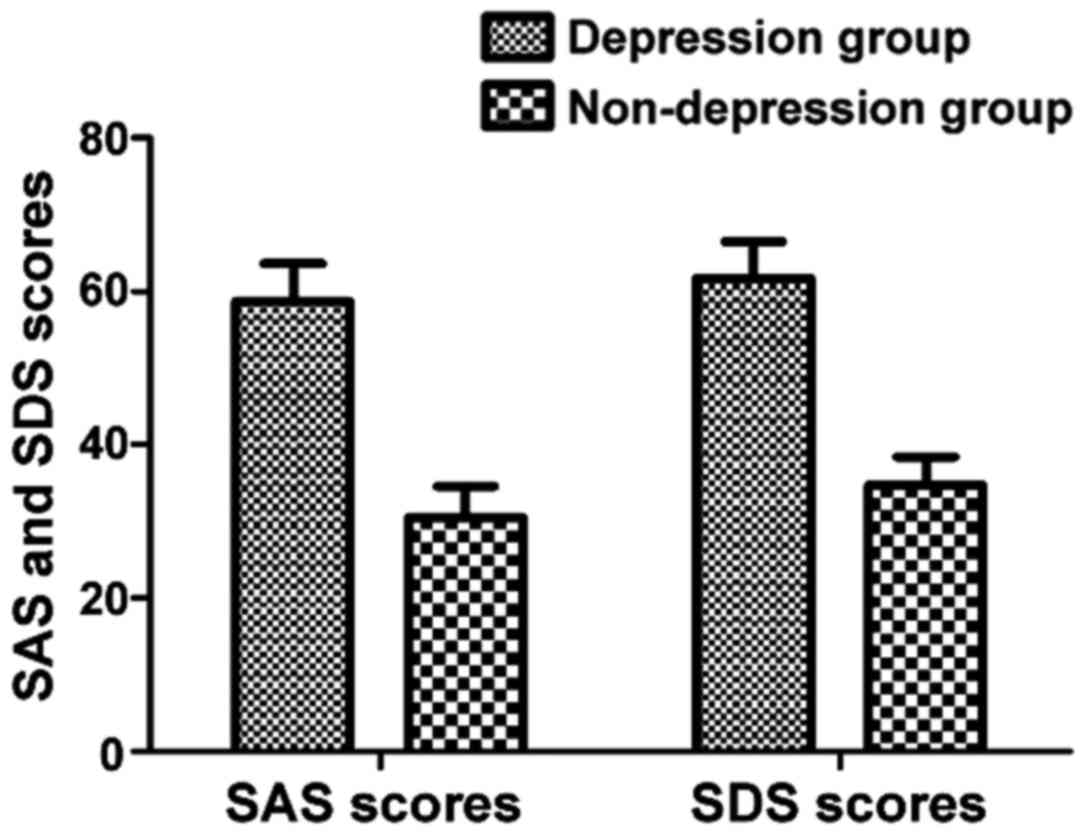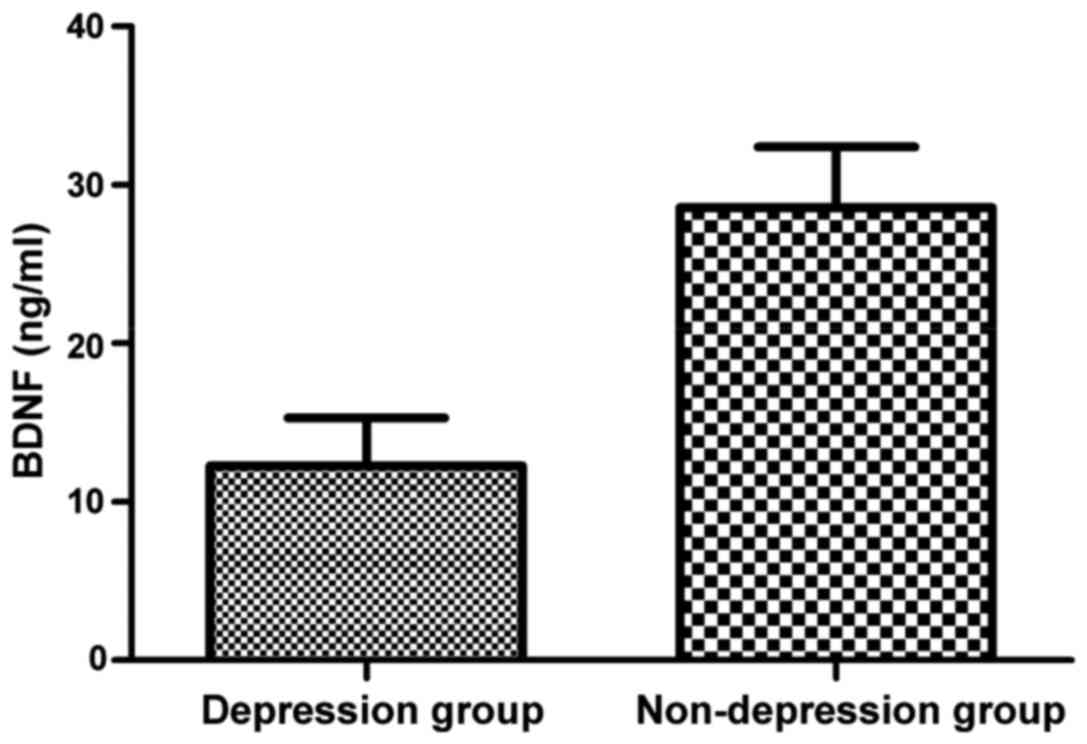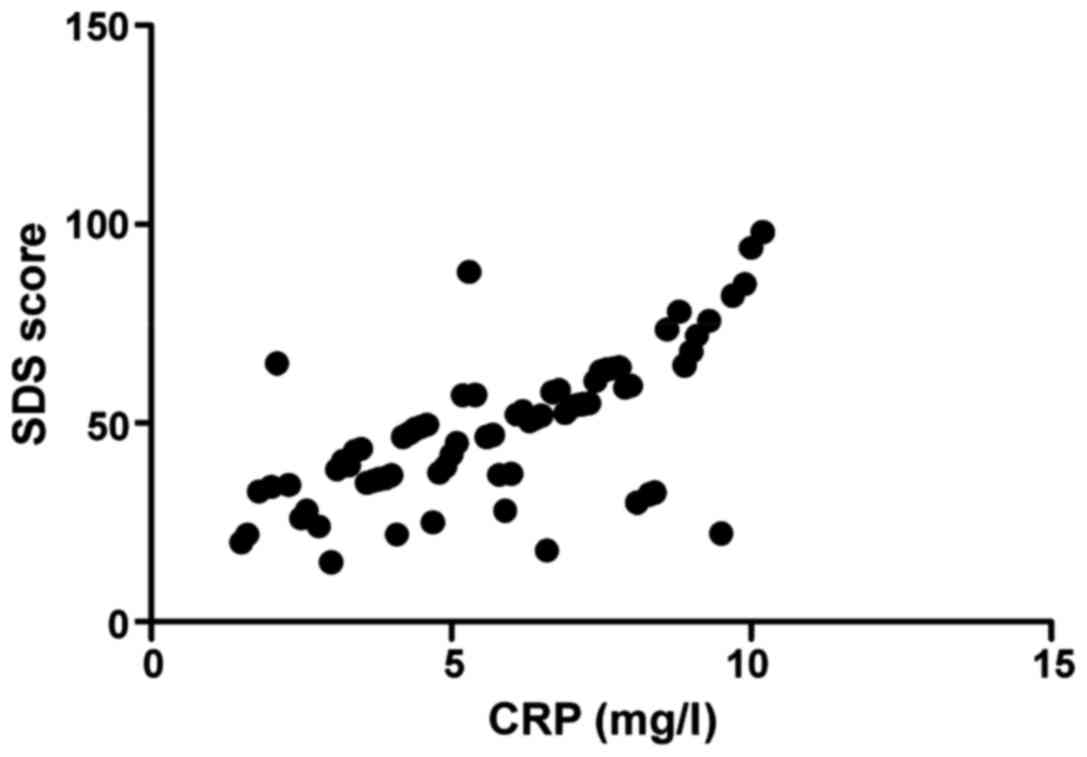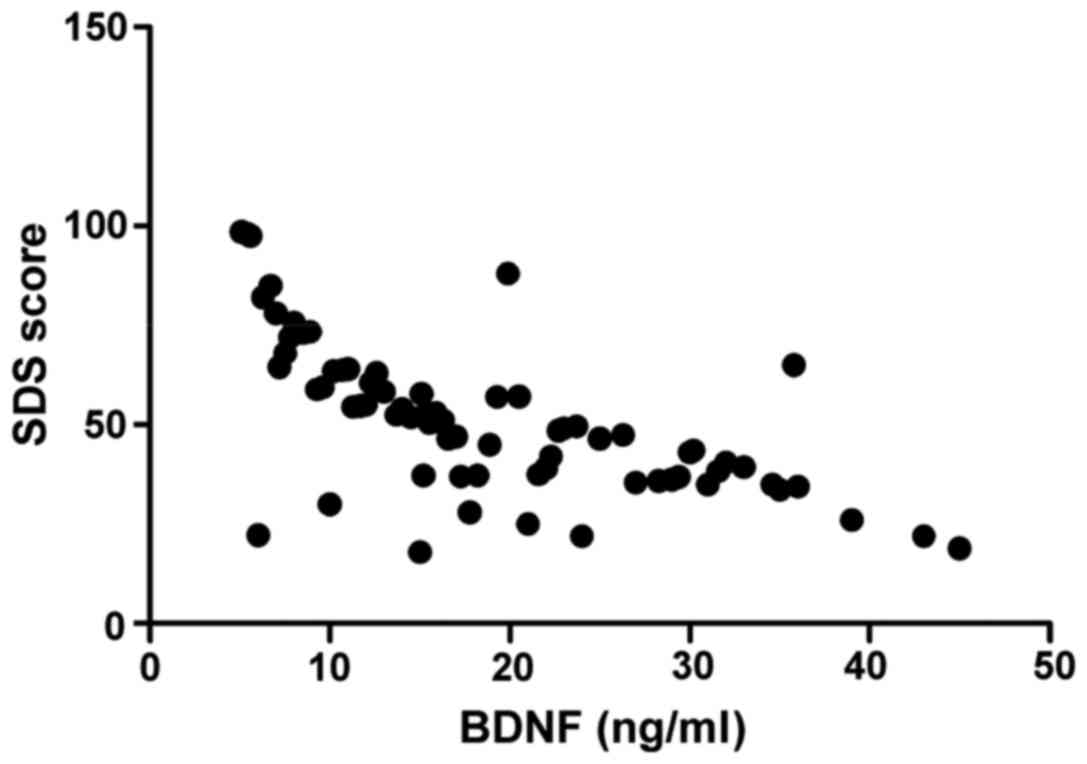Introduction
With the increase of social pressure and the pace of
life, mental illnesses, such as anxiety disorder, or even
depression disorder, are increasingly common in perimenopause women
due to hormonal metabolic disorders (1). Patients with perimenopausal syndrome
present a series of symptoms, such as dysphoria, irascibility, mood
swings and uncontrolled rage, which have a negative impact on the
patients themselves and their families and lead to a lower quality
of life (2,3). The main reasons for these symptoms are
the decline of ovarian function and significant reduction of
endogenous estrogen secretion.
Previous research has shown that the level of
brain-derived neurotrophic factor (BDNF) in peripheral serum is
closely related to the severity of depression (4), as it is an important component in
neurotrophic factors. BDNF in the cells of brain tissue is composed
of the tissues such as neurogliocyte and neuron in the brain tissue
cells (5) and BDNF in peripheral
serum is composed and secreted by blood platelets. When the
composition or content of blood palates is stimulated by external
or internal factors, a reduction or increase is observed in the
synthesis and secretion of BDNF (6).
When patients have depressive symptoms, a significant reduction in
the content, synthesis and release of BDNF in peripheral serum is
observed (7). As the inflammatory
system is regulated and mediated by multiple inflammatory factors,
antidepressants are often used in the treatment of the majority pf
patients with depression disorder to lower the level of
inflammatory factors and obtain a better treatment effect (8). However, more research data are
necessary to support the related mechanisms.
Perimenopausal syndrome refers to the related
clinical manifestations presented during the period from the first
time of clinical manifestation of menopause to the time of the last
menstruation. It is during this period that the probability of
depression is increased (9).
Therefore, the investigation on the risk factors associated with
depression in perimenopausal syndrome patients can avoid or reduce
the onset as much as possible or achieve the goal of early
detection and early treatment.
Patients and methods
General data
A total of 73 patients diagnosed with perimenopausal
syndrome treated in the Affiliated Hospital of Inner Mongolia
Medical University (Hohhot, China) from February, 2016 to January,
2017 were selected and divided into the depression (n=30) and
non-depression (n=42) groups. The patients were aged 47–53 years,
with an average age of 49.03±3.48 years. All selected cases
conformed to the related diagnostic requirements of perimenopausal
syndrome specified in the 8th edition of Obstetrics and Gynaecology
in China. The diagnosis of depression was based on the Hamiton's
Depression Scale in 1959 (score >20 points) and the Chinese
classification and diagnostic criteria of mental disorders.
Exclusion criteria: Patients aged <41 years; patients who had
taken related medicines that affected hormone level recently;
patients with severe heart, liver or renal insufficiency; patients
with malignant tumor; patients with mental disorders, such as
anxiety, depression or schizophrenia in their past medical history;
patients who did not sign the informed consent; patients without
complete clinical data or who dropped out midway.
The study was approved by the Ethics Committee of
Affiliated Hospital of Inner Mongolia Medical University. Written
informed consent was provided by the patients.
Methods
Measurement of the level of inflammatory factors in
peripheral serum [C-reactive protein (CRP), interleukin-6 (IL-6)
and tumor necrosis factor-α (TNF-α)] and BDNF: Peripheral blood
sample (15 ml) was drawn from each of the included patients after
fasting for solids and liquids for 10 h overnight, which was then
centrifuged to obtain the upper serum. Serum (10 ml) was used to
measure the level of inflammatory factors in peripheral serum by
immunoturbidimetry and the remaining 5 ml was used to measure the
level of BDNF by ELISA. All the reagents and instruments were
provided by Hangzhou Biological Instruments Co., Ltd. (Hangzhou,
China).
Calculation methods in self-rating anxiety scale
(SAS) and self-rating depression scale (SDS): SDS scores include 20
items and the critical score is 50 points. The higher the total
score is, the more obvious the depressive symptom will be. SAS
score: >50 points, SAS >60 points (mild anxiety), ≤60 points,
SAS <70 points (moderate anxiety), SAS ≥70 point (severe
anxiety).
Statistical analysis
Statistical Product and Service Solutions (SPSS)
19.0 software (IBM, Armonk, NY, USA) was used for data processing,
data collected were presented as mean ± SD, Chi-square test was
used for the comparison of enumeration data, correlation analysis
was conducted for the two factors, logistic analysis was conducted
for the related risk factors, and P<0.05 indicates that the
difference was considered to be statistically significant.
Results
Comparison of general data and main
life events between depression group and non-depression group of
patients with perimenopausal syndrome
The results showed that the differences in the age
and health condition of spouse between depression group and
non-depression group had no statistical significance (P<0.05),
while the number of cases having irregular menstruation, no work,
being divorced or widowed and having chronic disease in the
depression group was significantly higher than that in
non-depression group, and the difference was statistically
significant (P<0.05) (Table
I).
 | Table I.Comparisons of general data and main
life events between depression group and non-depression group of
patients with perimenopausal syndrome. |
Table I.
Comparisons of general data and main
life events between depression group and non-depression group of
patients with perimenopausal syndrome.
| Normal
information | Depression group
(n=30) | Non-depression group
(n=43) | P-value |
|---|
| Age (years) | 50.78±3.69 | 49.01±2.41 | 0.671 |
| Menstruation
(normal/abnormal) | 4/26 | 33/10 | 0.003 |
| Work (work/no
work) | 5/25 | 38/5 | 0.023 |
| Companion health
(health/chronic diseases) | 18/12 | 27/16 | 0.058 |
| Marital status
(good/divorced/widowed) | 5/23/2 | 38/4/1 | 0.001 |
| Self-chronic disease
(yes/no) | 26/4 | 16/27 | 0.048 |
Comparisons of SAS score and SDS score
between the depression and non-depression groups of patients with
perimenopausal syndrome
The results showed that SAS score and SDS score in
depression group was significantly higher than those in
non-depression group, and the differences were statistically
significant (P<0.05) (Fig.
1).
Comparison of BDNF level in peripheral
serum between the depression and non-depression groups of patients
with perimenopausal syndrome
The results showed that BDNF level in peripheral
serum in depression group was significantly lower than that in
non-depression group, and the difference was statistically
significant (P<0.05) (Fig.
2).
Comparison of inflammatory factor
levels in peripheral serum between the depression and
non-depression groups of patients with perimenopausal syndrome
The results showed that inflammatory factor levels
(CRP, IL-6 and TNF-α) in peripheral serum in depression group were
significantly higher than those in non-depression group and the
differences were statistically significant (P<0.05) (Table II).
 | Table II.Comparisons of inflammatory factor
levels in peripheral serum between the depression and
non-depression group of patients with perimenopausal syndrome. |
Table II.
Comparisons of inflammatory factor
levels in peripheral serum between the depression and
non-depression group of patients with perimenopausal syndrome.
| Group | No. | CRP (mg/l) | TNF-α (pg/ml) | IL-6 (ng/l) |
|---|
| Depression group | 30 | 5.39±1.46 | 13.67±3.19 | 16.45±2.92 |
| Non-depression
group | 43 | 2.38±1.09 | 7.06±3.56 | 8.02±1.87 |
| P-value |
| 0.001 | 0.001 | 0.001 |
Correlation analysis of inflammatory
factor levels in peripheral serum and BDNF level with
depression
The results showed CRP (r=0.793, P<0.001) and
TNF-α (r=0.682, P<0.001) were all positively correlated with SDS
score, while BDNF level was negatively correlated with SDS score
(r=−0.745, P<0.001) (Figs.
3–5).
Logistic regression analysis of risk
factors in predicting the onset of depression of patients with
perimenopausal syndrome
The results indicated that the menstrual condition,
chronic disease condition, inflammatory factor in peripheral serum
(CRP, IL-6 and TNF-α) and BDNP level had unique value in predicting
the onset of depression of patients with perimenopausal syndrome
(P<0.05) (Table III).
 | Table III.Logistic regression analysis of risk
factors in predicting the onset of depression of patients with
perimenopausal syndrome. |
Table III.
Logistic regression analysis of risk
factors in predicting the onset of depression of patients with
perimenopausal syndrome.
| Risk factors | P-value | OR value | 95% CI |
|---|
| Age (years) | 0.109 | 1.095 | 0.986–1.157 |
| Menstruation | 0.015 | 7.953 | 1.916–25.134 |
| Work | 0.054 | 1.046 | 0.988–1.119 |
| Companion health | 0.526 | 1.448 | 0.466–4.488 |
| Marital status | 0.052 | 1.165 | 1.054–1.538 |
| Self-chronic
disease | 0.043 | 1.005 | 0.928–1.113 |
| BDNF | 0.023 | 1.046 | 0.995–1.113 |
| CRP | 0.001 | 1.004 | 0.995–1.321 |
| IL-6 | 0.032 | 1.065 | 0.964–1.117 |
| TNF-α | 0.029 | 1.054 | 0.984–1.065 |
Discussion
As patients with depression are often in the
psychological state of low mood, it is easy to cause substantial
organ dysfunction, if not treated seriously for a long time.
Depression is a common impaired mental function syndrome (10), especially in this rapid development
world, the incidence of depression has become higher and higher
with the increase of life pressure (11). Patients with perimenopausal syndrome,
due to the metabolic disorders of hormone levels, are more likely
to develop autonomic nerve dysfunction (12), which can be further developed into
depression. Some patients have the symptom of depression from the
beginning of perimenopause which may continue or repeat until
menopause, while it may even continue for 5–10 years after
menopause to overcome by patients (13), which will bring serious negative
effects on patients themselves and their families as well as
society. The most essential reason of having depression for
patients with perimenopausal syndrome is the rapid reduction of
endogenic estrogen content, resulting in moodiness, mainly
manifested as irritability and depression (14). Thus, estrogen is often used in the
clinical treatment of perimenopausal syndrome, which can
effectively improve patients' depressed mood and promote their life
quality (15). Relevant research
data indicated that the use of exogenous estrogen in the treatment
of perimenopausal syndrome can lower the inflammatory factor level
and increase BDNF level, which can avoid onset of depression or
effectively improve the severity of depression (16). However, this conclusion is necessary
to be supported by more research data. BDNF is a protein component
(17) with wide application existing
in both central nervous system and peripheral nervous system of
mammals, which can defend against anxiety and depression by
mediating synapses by accelerating the differentiation of certain
neurons (18). Hippocampus in the
central nervous system is the main place where BDNF expression is
produced. When BDNF content decreases, the patient will be found in
an obvious depressive state (19).
This study found that BDNF level in the group of perimenopausal
syndrome patients with depression was significantly lower than that
in the group without depression and BDNF was negatively correlated
with SDS score, which was consistent with the conclusion.
The most common therapy for patients with depression
is to use antidepressant. Research has shown that there is an
obvious decline in patients' inflammatory factor level in
peripheral serum during the use of antidepressant, thus
inflammatory factor levels in peripheral serum are considered to be
correlated with depression and its severity (20).
The conclusion from this study is that inflammatory
factor levels in peripheral serum in depression group of patients
with perimenopausal syndrome are significantly higher than those in
non-depression group and inflammatory factor levels are positively
correlated with SDS scores. In general, inflammatory factor levels
in peripheral serum and BDNF level have important reference value
in the depression occurred during perimenopause and can be regarded
as the marker in evaluating the treatment effect of drug therapy on
depression disorder. The decline of BDNF level in peripheral serum
and increase of inflammatory factor levels demonstrate that the
patient is more likely to develop depression disorder
simultaneously or the depressive symptoms may be exacerbated.
Therefore, BDNF level and inflammatory factor levels in peripheral
serum have great significance in the diagnosis and treatment of
perimenopausal syndrome.
Acknowledgements
Not applicable.
Funding
This work was supported in part by the Natural
Science Foundation of Inner Mongolia (2017MS0828).
Availability of data and materials
All data generated or analyzed during this study are
included in this published article.
Authors' contributions
LG was for study design, LR and CZ were for data
collection and analysis, LG and CZ were for manuscript preparation.
All authors read and approved the final manuscript.
Ethics approval and consent to
participate
The study was approved by the Medical Ethics
Committee of Affiliated Hospital of Inner Mongolia Medical
University (no. INNER-MS-2015-IS-0043; Hohhot, China). Written
informed consent was obtained from all the patients.
Consent for publication
Not applicable.
Competing interests
The authors declare that they have no competing
interests.
References
|
1
|
Zhou B, Sun X, Zhang M, Deng Y and Hu J:
The symptomatology of climacteric syndrome: Whether associated with
the physical factors or psychological disorder in
perimenopausal/postmenopausal patients with anxiety-depression
disorder. Arch Gynecol Obstet. 285:1345–1352. 2012. View Article : Google Scholar : PubMed/NCBI
|
|
2
|
Gibbs Z, Lee S and Kulkarni J: Factors
associated with depression during the perimenopausal transition.
Womens Health Issues. 23:e301–e307. 2013. View Article : Google Scholar : PubMed/NCBI
|
|
3
|
Graziottin A and Serafini A: Depression
and the menopause: Why antidepressants are not enough? Menopause
Int. 15:76–81. 2009. View Article : Google Scholar : PubMed/NCBI
|
|
4
|
Sun N, Yang CX, Liu ZF, Li XR, Xu Y and
Zhang KR: Effects of polymorphisms of serotonin transporter
promoter (5-HTTLPR) and brain derived neurotrophic factor gene
(G196A rs6265) on the risk of major depressive disorder in the
Chinese Han population. Eur Rev Med Pharmacol Sci. 20:1852–1859.
2016.PubMed/NCBI
|
|
5
|
Studd JW: A guide to the treatment of
depression in women by estrogens. Climacteric. 14:637–642. 2011.
View Article : Google Scholar : PubMed/NCBI
|
|
6
|
Harte-Hargrove LC, Maclusky NJ and
Scharfman HE: Brain-derived neurotrophic factor-estrogen
interactions in the hippocampal mossy fiber pathway: Implications
for normal brain function and disease. Neuroscience. 239:46–66.
2013. View Article : Google Scholar : PubMed/NCBI
|
|
7
|
Scharfman HE and MacLusky NJ: Estrogen and
brain-derived neurotrophic factor (BDNF) in hippocampus: Complexity
of steroid hormone-growth factor interactions in the adult CNS.
Front Neuroendocrinol. 27:415–435. 2006. View Article : Google Scholar : PubMed/NCBI
|
|
8
|
Aguirre CC and Baudry M: Progesterone
reverses 17beta-estradiol-mediated neuroprotection and BDNF
induction in cultured hippocampal slices. Eur J Neurosci.
29:447–454. 2009. View Article : Google Scholar : PubMed/NCBI
|
|
9
|
Strauss JR: The reciprocal relationship
between menopausal symptoms and depressive symptoms: A 9-year
longitudinal study of American women in midlife. Maturitas.
70:302–306. 2011. View Article : Google Scholar : PubMed/NCBI
|
|
10
|
Tuomisto H, Salo P, Saarinen R, Kalleinen
N and Polo-Kantola P: The association of serum oestradiol level,
age, and education with cognitive performance in peri- and late
postmenopausal women. Maturitas. 71:173–179. 2012. View Article : Google Scholar : PubMed/NCBI
|
|
11
|
Song IU, Kim YD, Kim JS, Lee KS and Chung
SW: Can high-sensitivity C-reactive protein and plasma homocysteine
levels independently predict the prognosis of patients with
functional disability after first-ever ischemic stroke? Eur Neurol.
64:304–310. 2010. View Article : Google Scholar : PubMed/NCBI
|
|
12
|
Kroenke K, Spitzer RL and Williams JB: The
PHQ-9: Validity of a brief depression severity measure. J Gen
Intern Med. 16:606–613. 2001. View Article : Google Scholar : PubMed/NCBI
|
|
13
|
Wojnar M, Drózdz W, Araszkiewicz A,
Szymański W, Nawacka-Pawlaczyk D and Urbański R: Prevalence of
depressive disorders among perimenopausal women seeking
gynecological services. Psychiatr Pol. 37:811–824. 2003.(In
Polish). PubMed/NCBI
|
|
14
|
Huerta R, Mena A, Malacara JM and de León
JD: Symptoms at the menopausal and premenopausal years: Their
relationship with insulin, glucose, cortisol, FSH, prolactin,
obesity and attitudes towards sexuality. Psychoneuroendocrinology.
20:851–864. 1995. View Article : Google Scholar : PubMed/NCBI
|
|
15
|
Komesaroff PA, Esler MD and Sudhir K:
Estrogen supplementation attenuates glucocorticoid and
catecholamine responses to mental stress in perimenopausal women. J
Clin Endocrinol Metab. 84:606–610. 1999. View Article : Google Scholar : PubMed/NCBI
|
|
16
|
Miklowitz DJ: Delinquency, depression, and
psychosis among adolescents in foster care: What holds three heads
together? J Am Acad Child Adolesc Psychiatry. 53:1251–1253. 2014.
View Article : Google Scholar : PubMed/NCBI
|
|
17
|
Reinhardt JP, Horowitz A, Cimarolli VR,
Eimicke JP and Teresi JA: Addressing depression in a long-term care
setting: A phase II pilot of problem-solving treatment. Clin Ther.
36:1531–1537. 2014. View Article : Google Scholar : PubMed/NCBI
|
|
18
|
Kwasky AN and Groh CJ: Vitamin D,
depression and coping self-efficacy in young women: Longitudinal
study. Arch Psychiatr Nurs. 28:362–367. 2014. View Article : Google Scholar : PubMed/NCBI
|
|
19
|
Rosario JL, Bezerra Diógenes MS, Mattei R
and Leite JR: Differences and similarities in postural alterations
caused by sadness and depression. J Bodyw Mov Ther. 18:540–544.
2014. View Article : Google Scholar : PubMed/NCBI
|
|
20
|
Hayden EP, Olino TM, Mackrell SV, Jordan
PL, Desjardins J and Katsiroumbas P: Cognitive vulnerability to
depression during middle childhood: Stability and associations with
maternal affective styles and parental depression. Pers Individ
Dif. 55:892–897. 2013. View Article : Google Scholar : PubMed/NCBI
|


















